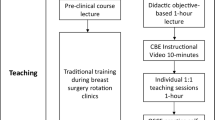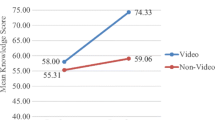Abstract
Purpose
The surgical technique for excising a nonpalpable breast lesion (NBL) can vary by surgeon and by pathology, posing a unique challenge for transfer of knowledge from educators to trainees. The objective of this study is to examine the teaching and learning of this procedure to bridge knowledge gaps to ultimately create a standardized paradigm for instruction regarding NBLs.
Methods
This was a multi-institutional, observational study in which six educators and six trainees underwent video-stimulated interviews. Interviews were transcribed and qualitative analysis was performed to identify common themes.
Results
Educator themes included “Experience-Based Skill Development”, “Under-Appreciated Difficulty of Lumpectomies by Trainees”, and “Challenges in Educating Trainees”. Trainee themes included “Request for Autonomy” and “Difficulty Understanding Key Steps from Educators”. Breast surgery educators discussed that part of the challenge is inherent to the operation, as there are no anatomical boundaries within the breast, thereby requiring the use of spatial thinking, further complicated by limited visualization due to a small incision. Trainees discussed the limits of verbal teaching, inability to conceptualize the location of the NBL, while also visualizing the operative working space Both educators and trainees expressed that the most effective interactions involved preoperative planning together and communication of expectations. Based on these results, a six-step structured paradigm was developed as a tool for educators to teach excision of nonpalpable breast lesions.
Conclusion
This study exposes key differences in concepts that educators and trainees consider during excision of NBLs. Understanding these challenges and consistently using the proposed structured paradigm may improve the teaching and learning of the skills required for this operation.
Similar content being viewed by others
References
Benson JR, Jatoi I, Keisch M, Esteva FJ, Makris A, Jordan VC. Early breast cancer. Lancet. 2009. https://doi.org/10.1016/S0140-6736(09)60316-0.
Lynge E, Ponti A, James T, Májek O, von Euler-Chelpin M, Anttila A, Fitzpatrick P, Frigerio A, Kawai M, Scharpantgen A, et al. Variation in detection of ductal carcinoma in situ during screening mammography: a survey within the international cancer screening network. Eur J Cancer. 2014. https://doi.org/10.1016/j.ejca.2013.08.013.
Sharek D, Zuley ML, Zhang JY, Soran A, Ahrendt GM, Ganott MA. Radioactive seed localization versus wire localization for lumpectomies: a comparison of outcomes. Am J Roentgenol. 2015. https://doi.org/10.2214/AJR.14.12743.
Cox CE, Garcia-Henriquez N, Glancy MJ, Whitworth P, Cox JM, Themar-Geck M, Prati R, Jung M, Russell S, Appleton K, et al. Pilot study of a new nonradioactive surgical guidance technology for locating nonpalpable breast lesions. Ann Surg Oncol. 2016. https://doi.org/10.1245/s10434-015-5079-x.
Cheang E, Ha R, Thornton CM, Mango VL. Innovations in image-guided preoperative breast lesion localization. Br J Radiol. 2018. https://doi.org/10.1259/bjr.20170740
Kelly BN, Webster AJ, Lamb L, Spivey T, Korotkin JE, Henriquez A, Gadd MA, Hughes KS, Lehman CR, Smith BL, Specht MC. Magnetic seeds: an alternative to wire localization for nonpalpable breast lesions. Clin Breast Cancer. 2022. https://doi.org/10.1016/j.clbc.2022.01.003.
Huffman EM, Martin JR, Stefanidis D. Teaching technical surgery. Surgery. 2020. https://doi.org/10.1016/j.surg.2019.05.026.
Roberts NK, Williams RG, Kim MJ, Dunnington GL. The briefing, intraoperative teaching, debriefing model for teaching in the operating room. J Am Coll Surg. 2009. https://doi.org/10.1016/j.jamcollsurg.2008.10.024.
Pernar LI, Peyre SE, Hasson RM, Lipsitz S, Corso K, Ashley SW, Breen EM. Exploring the content of intraoperative teaching. J Surg Educ. 2016;73(1):79–84. https://doi.org/10.1016/j.jsurg.2015.09.008.
Collings A, Doster D, Longtin K, Choi J, Torbeck L, Stefanidis D. Surgical resident perspectives on the preferred qualities of effective intraoperative teachers: a qualitative analysis. Acad Med. 2023. https://doi.org/10.1097/ACM.0000000000005131.
Timberlake MD, Mayo HG, Scott L, Weis J, Gardner AK. What do we know about intraoperative teaching? Ann Surg. 2017. https://doi.org/10.1097/SLA.0000000000002131.
Rose JS, Waibel BH, Schenarts PJ. Disparity between resident and faculty surgeons’ perceptions of preoperative preparation, intraoperative teaching, and postoperative feedback. J Surg Educ. 2011. https://doi.org/10.1016/j.jsurg.2011.04.003.
Rao A, Tait I, Alijani A. Systematic review and meta-analysis of the role of mental training in the acquisition of technical skills in surgery. Am J Surg. 2015. https://doi.org/10.1016/j.amjsurg.2015.01.028.
Anton NE, Beane J, Yurco AM, Howley LD, Bean E, Myers EM, Stefanidis D. Mental skills training effectively minimizes operative performance deterioration under stressful conditions: results of a randomized controlled study. Am J Surg. 2018. https://doi.org/10.1016/j.amjsurg.2017.09.039.
Dunkin B, Adrales GL, Apelgren K, Mellinger JD. Surgical simulation: a current review. Surg Endosc. 2007. https://doi.org/10.1007/s00464-006-9072-0.
Dawe SR, Windsor JA, Broeders JA, Cregan PC, Hewett PJ, Maddern GJ. A systematic review of surgical skills transfer after simulation-based training: laparoscopic cholecystectomy and endoscopy. Ann Surg. 2014. https://doi.org/10.1097/SLA.0000000000000245. (PMID: 24100339).
Koichopolos J, Hawel J, Shlomovitz E, Habaz I, Elnahas A, Alkhamesi NA, Schlachta CM. Correlation of surgical trainee performance on laparoscopic versus endoscopic simulation. Surg Endosc. 2020. https://doi.org/10.1007/s00464-019-06978-6.
Accreditation Council for Graduate Medical Education. ACGME program requirements for graduate medical education in general surgery. https://www.acgme.org/globalassets/pfassets/programrequirements/440_generalsurgery_2020.pdf. Accessed May 22, 2023.
Roark AA, Ebuoma LO, Ortiz-Perez T, Sepulveda KA, Severs FJ, Wang T, Benveniste AP, Sedgwick EL. Impact of simulation-based training on radiology trainee education in ultrasound-guided breast biopsies. J Am Coll Radiol. 2018;15(10):1458–63. https://doi.org/10.1016/j.jacr.2017.09.016. (Epub 2017 Dec 6 PMID: 29222002).
Kankam H, Lenti L, Razai MS, Hourston G, Khatib M. The role of simulation in training breast surgeons: a systematic review. Ann R Coll Surg Engl. 2021;103(5):318–23. https://doi.org/10.1308/rcsann.2020.7138.
Sandelowski M. What’s in a name? Qualitative description revisited. Res Nurs Health. 2010. https://doi.org/10.1002/nur.20362. (PMID: 20014004).
Charmaz K. The power of constructivist grounded theory for critical inquiry. Qual Inq. 2017. https://doi.org/10.1177/1077800416657105.
Glaser BG. The constant comparative method of qualitative analysis. Soc Probl. 1965. https://doi.org/10.2307/798843.
Guest G, Bunce A, Johnson L. How many interviews are enough?: an experiment with data saturation and variability. Field Methods. 2006. https://doi.org/10.1177/1525822X05279903.
Acknowledgements
The authors wish to acknowledge the educators and learners who participated in the interviews and allowed us to report these findings.
Funding
No funding was received for the conduct of this study or preparation of the manuscript.
Author information
Authors and Affiliations
Corresponding author
Ethics declarations
Conflict of interest
None.
Informed consent
Informed consent was obtained from all participants in this study. All authors certify that they have no affiliations with or involvement in any organization or entity with any financial interest or non-financial interest in the subject matter or materials discussed in this manuscript.
Rights and permissions
Springer Nature or its licensor (e.g. a society or other partner) holds exclusive rights to this article under a publishing agreement with the author(s) or other rightsholder(s); author self-archiving of the accepted manuscript version of this article is solely governed by the terms of such publishing agreement and applicable law.
About this article
Cite this article
Abidi, H.H., Littleton, E.B., McAuliffe, P.F. et al. Unpacking the surgical approach to nonpalpable breast lesions: bridging the knowledge gap between educators and trainees. Global Surg Educ 3, 11 (2024). https://doi.org/10.1007/s44186-023-00211-8
Received:
Revised:
Accepted:
Published:
DOI: https://doi.org/10.1007/s44186-023-00211-8




